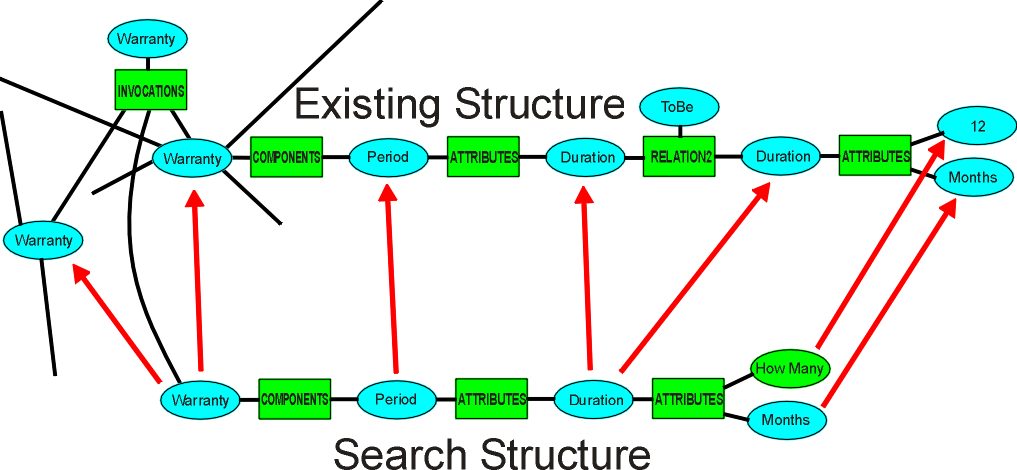Searching
In the text, we have
The warranty period is fifteen months from the delivery date.
Some possible search strings
Warranty period
Warranty period is how many months from the delivery date
Warranty period is twelve months from the delivery date
The search string can
 | be a means of finding and displaying the relevant text (the clauses, subclauses and
sentences that produced the matched structure) |
 | use a dummy variable (how many, how much) which will be matched and resolved against the
structure |
 | assert a fact and have its validity confirmed or denied or be unknown. |
Taking the simplest case, we want to search for
The warranty period
and return a reference to the appropriate sentence or sentences that created this part
of the structure.
We set a store level so that all construction during searching can be undone, then
create the structure using a Search form, then transform it into a structure suitable for
searching – a search map. Unlike matching against a preposition map, where we have
the objects already and wish to find the possible connections, here we are using a new
structure to probe an existing structure. That means finding other objects that are
invocations of the same parent object (or of its synonym). We need to ignore parents which
have to do with words or word structure (warranty is an invocation of SingularNoun, for
example).
The word tokens, while adequate in this example, are not a good starting point –
we are not interested in articles or verb auxiliaries, as they are not part of the
transformed structure. In the case of the simple example above, two of the tokens are
nouns and survive the transformation to appear in the structure, and are connected
together through an operator used in matching.
A token built from the search string will have connections to an ANDPARSE operator in
the parse chain, may have connections to SingularNoun and other word elements. A unique
token, such as California or a token from the local dictionary ("Seller"), may
have connections to other sentences. All of these connections need to be ignored.
We use the Sentence node (the object representing the sentence or query) to determine
what part of the structure should be used for searching. Its address is written into every
link (an "origin" field) that is built for the structure. Only these links will
be used in the searching process. That is, any link with a different origin is ignored.
Searching has to be able to step over ToBe operators - there is no difference (assuming
the time range is valid) between
the warranty period of six weeks
the warranty period is six weeks
A fragment of the existing structure and the search structure might look like

In this case, a variable with a range in the search structure will be matched to a
single value in the existing structure, providing an answer to a query posed as a
statement but using "how many" instead of a value. Nonmatching units are handled
during searching, so fourteen days will match two weeks.
The result of matching one structure against another is far greater precision of
matching than word matching can provide, and the ability to extract values or logical
states from the structure.
